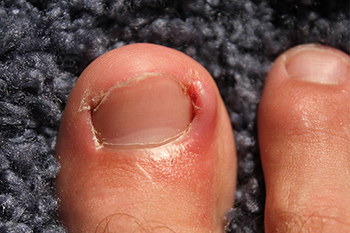
The pain and discomfort that can happen from having an ingrown toenail can cause difficulty in completing daily activities. They occur when the side of the toenail grows into the skin instead of over it. Ingrown toenails can occur from wearing shoes that are too tight, such as high heels or shoes with a pointed toe. They may also happen if the toenails are trimmed incorrectly or possibly for genetic reasons. Some patients are born with abnormal nail shapes, and this may cause an ingrown toenail to develop. The first sign an ingrown toenail is developing can be mild swelling and redness, and if not treated promptly, the nail may become painful. The nail may turn a white or yellow color, which may precede a possible infection. Soaking the affected foot in warm water may bring mild relief, followed by using a piece of cotton to gently remove the nail from digging into the skin. This may provide temporary relief and will ultimately need to be examined by a podiatrist. If you have developed this condition, it is suggested that you consult with this type of doctor who can successfully treat ingrown toenails.
Ingrown toenails may initially present themselves as a minor discomfort, but they may progress into an infection in the skin without proper treatment. For more information about ingrown toenails, contact Elie C. Daniel, DPM of Illinois. Our doctor can provide the care you need to keep you pain-free and on your feet.
Ingrown Toenails
Ingrown toenails are caused when the corner or side of a toenail grows into the soft flesh surrounding it. They often result in redness, swelling, pain, and in some cases, infection. This condition typically affects the big toe and may recur if it is not treated properly.
Causes
- Improper toenail trimming
- Genetics
- Improper shoe fitting
- Injury from pedicures or nail picking
- Abnormal gait
- Poor hygiene
You are more likely to develop an ingrown toenail if you are obese, have diabetes, arthritis, or have any fungal infection in your nails. Additionally, people who have foot or toe deformities are at a higher risk of developing an ingrown toenail.
Symptoms
Some symptoms of ingrown toenails are redness, swelling, and pain. In rare cases, there may be a yellowish drainage coming from the nail.
Treatment
Ignoring an ingrown toenail can have serious complications. Infections of the nail border can progress to a deeper soft-tissue infection, which can then turn into a bone infection. You should always speak with your podiatrist if you suspect you have an ingrown toenail, especially if you have diabetes or poor circulation.
If you have any questions, please feel free to contact our offices located in Princeton, Peru, and Mendota, IL . We offer the newest diagnostic and treatment technologies for all your foot care needs.
